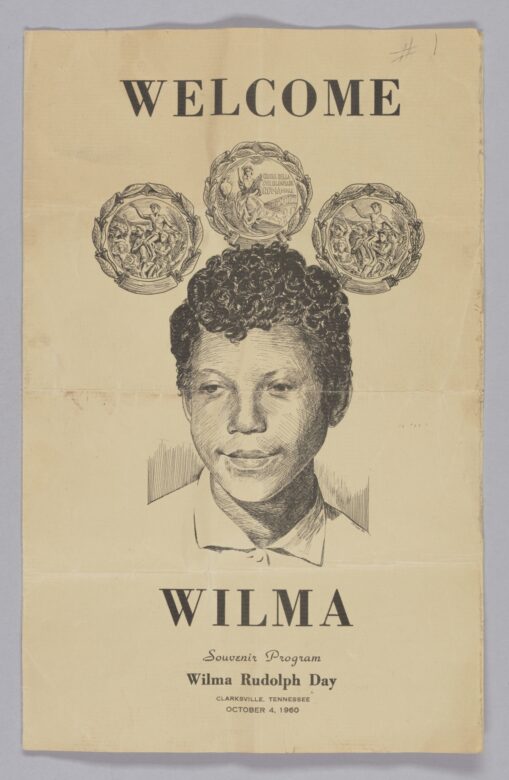Collection The Decatur House Slave Quarters
In 1821-1822, Susan Decatur requested the construction of a service wing. The first floor featured a large kitchen, dining room,...

Main Content
How Long? 3 minutes
Wilma Rudolph was born on June 23, 1940, in Saint Bethlehem, Tennessee. As a child, she suffered from several serious illnesses, including pneumonia, polio, and scarlet fever. She wore a leg brace until the age of nine. After recovering the use of her leg, Rudolph turned to sports. She excelled at basketball in high school, earning an All-American designation and setting a state record for scoring 49 points in one game. Her basketball coach observed that Rudolph had an advantage over her competitors. She was incredibly fast on the court.1
By chance, she met with a college coach who introduced her to track and field. She started training with the Tennessee State University track team while in high school. In 1956, Rudolph competed in the Melbourne, Australia Olympics, winning a bronze medal as part of the 4x100 relay.2
After training for four more years, Rudolph earned three gold medals in the 1960 Rome Olympics, winning the 100m, 200m, and 4x100m relay. She was the first female athlete in American history to win three gold medals in a single Olympics.3

Wilma Rudolph trains for the 1959 Pan American Games.
University of Tennessee Knoxville LibraryWhen Rudolph returned to her hometown of Clarksville, Tennessee, she was celebrated with a parade and dinner. The town had originally planned two separate celebrations, one for white residents and one for Black residents. When Rudolph learned of this idea, she refused to participate. Her insistence resulted in an integrated celebration, heralded for decades as an act of leadership and courage.4 The parade to honor Rudolph was the first racially integrated event to take place in the history of Clarksville.5
Wilma Rudolph briefly met Vice President Richard Nixon in October 1960 during a presidential campaign stop in Nashville, Tennessee. At a previous campaign event, Nixon had emphasized the role of African-American athletes at the Rome Olympics. Although Nixon emphasized male athletes in his public comments, Second Lady Thelma “Pat” Nixon added, “Don’t forget my girl, Wilma Rudolph.”6

A souvenir program commemorating Wilma Rudolph Day in Clarksville, Tennessee celebrating her achievements during the 1960 Summer Olympics.
National Museum for African American History and CultureOn April 14, 1961, Wilma Rudolph visited Washington, D.C., with her mother Blanche Rudolph, her coach Edward Temple, and her friend Robert Logan, to speak with Vice President Lyndon B. Johnson about physical fitness. Vice President Johnson then phoned President John F. Kennedy and secured their invitation to the White House.7
After posing for photographs, President Kennedy attempted to sit in his chair but missed, falling to the floor. As he got up, he said, “It’s not every day that I get to meet an Olympic champion.”8
The visit lasted thirty minutes until almost five o’clock in the evening—forcing Rudolph to miss her 5:05 PM flight back to Baton Rouge, Louisiana, for a race the next morning. Luckily, Vice President Johnson was able to arrange a later flight for the sprinter.9

John F. Kennedy and Vice President Lyndon B. Johnson meet with Olympic track and field gold medalist Wilma Rudolph in the Oval Office, White House. From left to right in the photograph: President Kennedy; Wilma Rudolph; Rudolph’s mother Blanche Rudolph; Vice President Johnson; friend Robert Logan (standing); coach of the 1960 women’s Olympic track team Edward Temple.
John F. Kennedy Presidential Library and Museum/NARARudolph was named Female Athlete of the Year for 1961. She also won the Sullivan Award in 1961, given to America’s most outstanding amateur athlete. Rudolph graduated with a degree in education from Tennessee State in 1961.10
Rudolph was one of the most famous American athletes of her time. Her life story was made into a two-hour television movie in 1977, which was written and produced by Olympic historian, Bud Greenspan. He referred to Rudolph as the “Jesse Owens of women’s track and field.”11
After her running career, Wilma Rudolph worked as a track coach at Indiana’s DePauw University and served as a United States goodwill ambassador to French West Africa. She also started the Wilma Rudolph Foundation, a nonprofit organization focused on the importance of sports in local communities. She passed away at age 54 of brain cancer.12
In 1821-1822, Susan Decatur requested the construction of a service wing. The first floor featured a large kitchen, dining room,...
Honoring some of the greatest moments in sports history has become a tradition at the White House. Presidents and their...
Baseball has been known as our national pastime and has links to the presidency as far back as the Abraham...
No sport is more closely tied to the American presidency than baseball. One of Washington’s first baseball fields was lo...
In 1816, Commodore Stephen Decatur, Jr. and his wife Susan moved to the nascent capital city of Washington, D.C. With...
First Lady Lou Hoover's invitation to Jessie L. DePriest to a White House tea party in 1929 created a storm of...
The White House Collection and the Atlantic World Jennifer L. Anderson, Mahogany: The Costs of Luxury in Early America (Cambridge,...
As part of the White House Historical Association’s 60th anniversary celebration in 2021, the Next-Gen Leaders (NGL) initiative was announced. Th...
Simmie Knox
JAMES ARCHER ABBOTT is the Executive Director of the Lewes Historical Society in Lewes, Delaware. His publications include JANSEN, JANSEN...
2023 2023 Communicator Awards White House History Quarterly 65: Every President Has Walked These Grounds, Award of Excellence, Design Features, Copywriting for Corporate...
As Senior Advisor, Kevin Sullivan provides guidance and counsel on the Bush Center's development and communications efforts, with special focus...